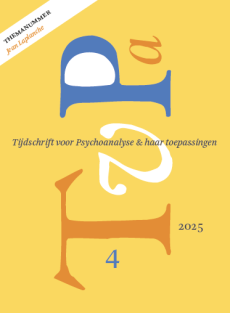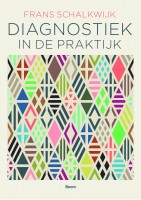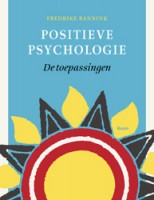Psychoanalyse als klinische fenomenologie
Summary
Psychoanalysis as clinical phenomenology
The phenomenological characteristics of the psychoanalytic therapeutic attitude are investigated. The author suggests that psychoanalytic practice derives its scientific nature precisely from a basically phenomenological attitude and that every hermeneutic reflection and interpretation is subordinate to this. In the same way as the phenomenological investigator, the psychoanalytic psychotherapist tries to explore his object of investigation, the inner world of the patient, thoroughly and cautiously, suspending all prejudices. In the light of the central parameters of the unconscious, free association and transference, the phenomenological character of the concrete analytical situation is explored and confronted with phenomenologists such as Husserl, Heidegger, Merleau-Ponty and Derrida. The author offers a plea, illustrated by the Bionian approach to the analytic process, in psychoanalysis no less than in phenomenology, for a primacy of observation above language.
Literatuur
- BATEMAN, A. & FONAGY, P. (2007). Mentaliseren bij de borderline persoonlijkheidsstoornis — Praktische gids voor hulpverleners in de ggz. Houten: Bohn Stafleu van Loghum.
- BERGSON, H. (1903). Inleiding tot de metafysica. Meppel/Amsterdam: Boom, 1989.
- BERNET, R. (1986). Derrida en Husserl — Het supplement als oorsprong. In S. IJsseling (red.), Jacques Derrida — Een inleiding in zijn denken (p. 90-112). Baarn: Ambo.
- BION, W.R. (1962). Learning from experience. Londen: Karnac, 1991.
- BION, W.R. (1963). Elements of psychoanalysis. Londen: Karnac, 1989.
- BION, W.R. (1965). Transformations. Londen: Karnac, 1991.
- BION, W.R. (1970). Attention and interpretation. Londen: Karnac, 1988.
- BOER, T. DE (1988). Tussen filosofie en profetie — De wijsbegeerte van Emmanuel Levinas. Baarn: Ambo.
- BOLLAS, C. (1987). The shadow of the object — Psychoanalysis of the unthought known. Londen: Free Association Books.
- CAMBIEN, J. (1994). De waarneming van het weerloze. Wijsgerig Perspectief, 34, 7-12. de waelhens, a. (1958). Réflexions sur les rapports de la phénoménologie et de la psychanalyse. In A. De Waelhens, Existence et signification (p. 191-211). Leuven: Nauwelaerts.
- DEBEN-MAGER, M. & verheugt-pleiter, a. (red.) (2009). Bankgeheimen — Over de werkzaamheid van psychoanalytische behandelingen. Assen: Van Gorcum.
- DEKKERS, W. (2007). Maurice Merleau- Ponty — Fenomenologie van het lichaam. In C. Aydin (red.), De vele gezichten van de fenomenologie (p. 118-135). Kampen: Klement/Pelckmans.
- DERRIDA, J. (1967). De stem en het fenomeen — Inleiding tot het probleem van het teken in de fenomenologie van Husserl. Baarn: Ambo, 1989.
- ETTINGER, B. (2007). Diotima and the matrixial transference — Psychoanalytical encounter-event as pregnancy in beauty. In C. N. van der Merwe & H. Viljoen (red.), Across the threshold — Explorations of liminality in literature (p. 119-140). New York: Peter Lang.
- FERRO, A. (2006). Psychoanalysis as therapy and storytelling. Londen/New York: Routledge.
- FREUD, S. (1915). Het onbewuste. Werken 7 (p. 65-112). Amsterdam: Boom, 2006.
- FREUD, S. (1937). Constructies in de analyse. Werken 10 (p. 308-319). Amsterdam: Boom, 2006.
- GROTSTEIN, J.S. (2007). A beam of intense darkness — Wilfred Bion’s legacy to psychoanalysis. Londen: Karnac Books.
- HEIDEGGER, M. (1927). Zijn en tijd. Nijmegen: SUN/Kritak, 1998.
- HUSSERL, E. (1911). Filosofie als strenge wetenschap. Amsterdam/Meppel: Boom, 1980.
- IJSSELING, S. (1990). Mimesis — Over schijn en zijn. Baarn: Ambo.
- IJSSELING, S. (2007). Edmund Husserl — De vader van de fenomenologie. In C. Aydin (red.), De vele gezichten van de fenomenologie (p. 15-33). Kampen: Klement/Pelckmans.
- LEVRAU, F. (2010). Psychoanalyse in tijden van evidence-based medicine — Over de ideologische druk op de psychoanalyse. Tijdschrift voor Psychoanalyse, 16, 3-14.
- MERLEAU-PONTY, M. (1945). Fenomenologie van de waarneming. Amsterdam: Ambo, 1997.
- MERLEAU-PONTY, M. (1953). Lof der wijsbegeerte. Meppel/Amsterdam: Boom, 1979.
- MOOIJ, A. (1992). Psychoanalyse, fenomenologie en hermeneutiek. In A. Mooij & G. Widdershoven (red.), Hermeneutiek en psychologie — Interpretatie en theorievorming, onderzoek en psychotherapie (p. 114-130). Meppel/Amsterdam: Boom.
- MOOIJ, A. (2002). Psychoanalytisch gedachtegoed — Een modern perspectief. Amsterdam: Boom.
- OGDEN, T. (1994). Subjects of analysis. Northvale/Londen: Jason Aronson Inc.
- RICOEUR, P. (1970). Freud and philosophy — An essay on interpretation. New Haven/Londen: Yale University Press.
- THYS, M. (1993). Van mimesis tot deconstructie — Het metafysisch statuut van de psychoanalytische duiding. Psychoanalyse, 9, 179-200.
- THYS, M. (1994). Waarheid en betekenis: psychotherapie als duidingspraktijk. Wijsgerig Perspectief, 34, 12-17.
- THYS, M. (1998a). Het ‹sujet trouvé› — Interpreteren en subjectiviteit. Psychoanalyse, 12, 153-167.
- THYS, M. (1998b). Tussen psychose en mystiek — Bion en de filosofie. In J. Dehing (red.), Een bundel intense duisternis — Psychoanalytische opstellen rond W. R. Bion (p. 85-99). Leuven/Apeldoorn: Garant.
- THYS, M. (2006). Fascinatie — Een fenomenologisch-psychoanalytische verkenning van het onmenselijke. Amsterdam: Boom.
- VEDDER, B. (2007). Martin Heidegger — Van verval naar eigenlijke fenomenologie. In C. Aydin (red.), De vele gezichten van de fenomenologie (p. 24-53). Kampen: Klement/Pelckmans.
- VERHAEGHE, P. (2009). Het einde van de psychotherapie. Amsterdam: De Bezige Bij.
- VERMOTE, R. (2007). In contact zijn met het psychoanalytisch object — ‹Finding the wavelength›. In M. Kinet & W. Vanmechelen (red.), Tussen ruis en storingen — De golflengte vinden in psychoanalytische therapie (p. 47-59). Antwerpen/Apeldoorn: Garant.
- WILLE, R. (2006). Over het vermogen tot het verdragen van psychische pijn. Tijdschrift voor Psychoanalyse, 12, 287-300.
 © 2009-2025 Uitgeverij Boom Amsterdam
© 2009-2025 Uitgeverij Boom Amsterdam
ISSN 1382-516x
De artikelen uit de (online)tijdschriften van Uitgeverij Boom zijn auteursrechtelijk beschermd. U kunt er natuurlijk uit citeren (voorzien van een bronvermelding) maar voor reproductie in welke vorm dan ook moet toestemming aan de uitgever worden gevraagd:
Behoudens de in of krachtens de Auteurswet van 1912 gestelde uitzonderingen mag niets uit deze uitgave worden verveelvoudigd, opgeslagen in een geautomatiseerd gegevensbestand, of openbaar gemaakt, in enige vorm of op enige wijze, hetzij elektronisch, mechanisch door fotokopieën, opnamen of enig andere manier, zonder voorafgaande schriftelijke toestemming van de uitgever.
Voor zover het maken van kopieën uit deze uitgave is toegestaan op grond van artikelen 16h t/m 16m Auteurswet 1912 jo. Besluit van 27 november 2002, Stb 575, dient men de daarvoor wettelijk verschuldigde vergoeding te voldoen aan de Stichting Reprorecht te Hoofddorp (postbus 3060, 2130 KB, www.reprorecht.nl) of contact op te nemen met de uitgever voor het treffen van een rechtstreekse regeling in de zin van art. 16l, vijfde lid, Auteurswet 1912.
Voor het overnemen van gedeelte(n) uit deze uitgave in bloemlezingen, readers en andere compilatiewerken (artikel 16, Auteurswet 1912) kan men zich wenden tot de Stichting PRO (Stichting Publicatie- en Reproductierechten, postbus 3060, 2130 KB Hoofddorp, www.cedar.nl/pro).
No part of this book may be reproduced in any way whatsoever without the written permission of the publisher.
Nieuwsbrief Boom Psychologie
Meld u nu aan en ontvang maandelijks de Boom Psychologie nieuwsbrief met aantrekkelijke aanbiedingen en de nieuwe uitgaven.
Aanmelden


